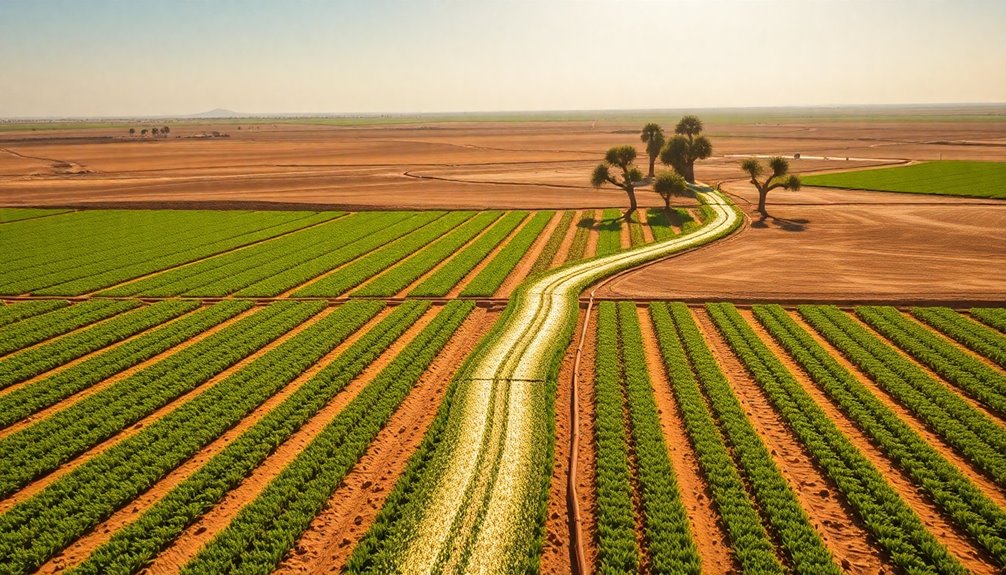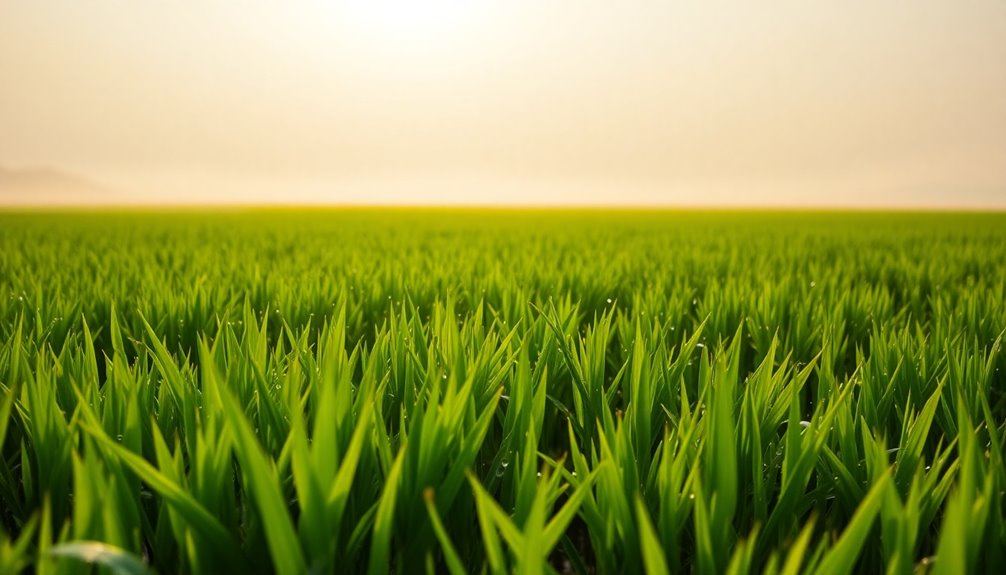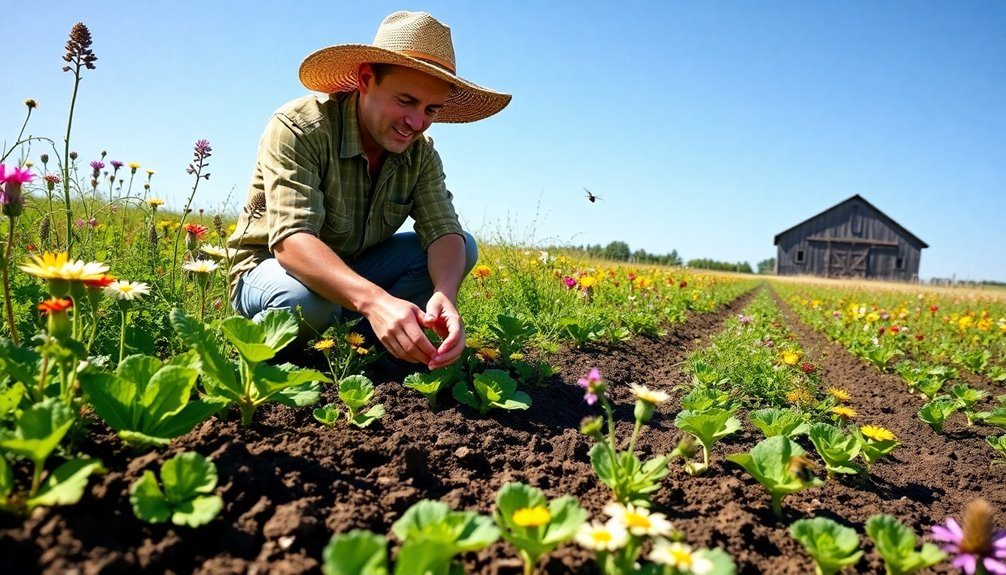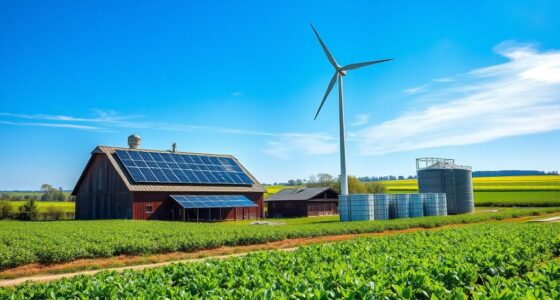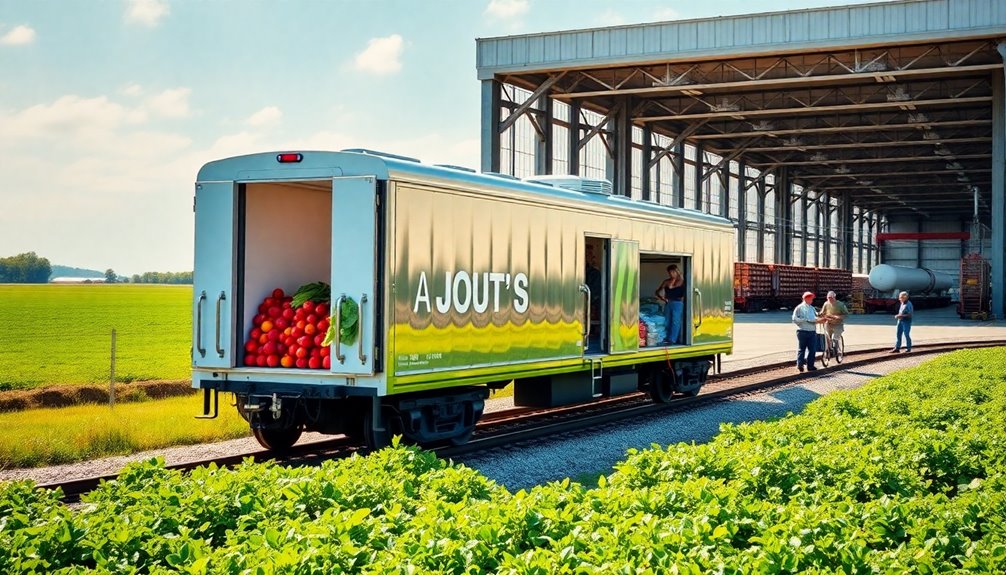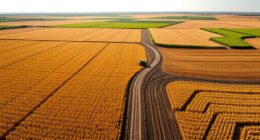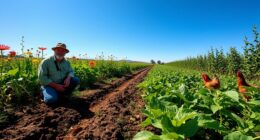When farming in dry or desert areas, you should focus on methods that conserve water and enhance soil health. Drip irrigation is essential, delivering water directly to plants and cutting usage by up to 50%. Choose drought-resistant crops like sorghum and millet, and consider intercropping to maximize resource efficiency. Techniques like rainwater harvesting and using organic materials improve moisture retention. Don't forget about soil testing to tailor your amendments. Embracing local plants and technology, such as automated irrigation systems, boosts resilience. There's so much more you can implement for success in arid farming!
Key Takeaways
- Drip Irrigation efficiently delivers water directly to crops, reducing evaporation and conserving up to 50% more water than traditional methods.
- Drought-Resistant Crops like sorghum and millet are ideal for arid regions, thriving in limited rainfall conditions while improving soil health through legumes.
- Rainwater Harvesting captures and stores rainfall, decreasing dependency on groundwater and providing water during dry periods through cisterns and tanks.
- Soil Improvement Techniques such as adding organic material and practicing conservation tillage enhance soil structure, moisture retention, and overall health.
- Technology Integration, including soil moisture sensors and automated irrigation, optimizes water use and supports crop resilience in dry farming conditions.
Farming Methods in Arid Regions
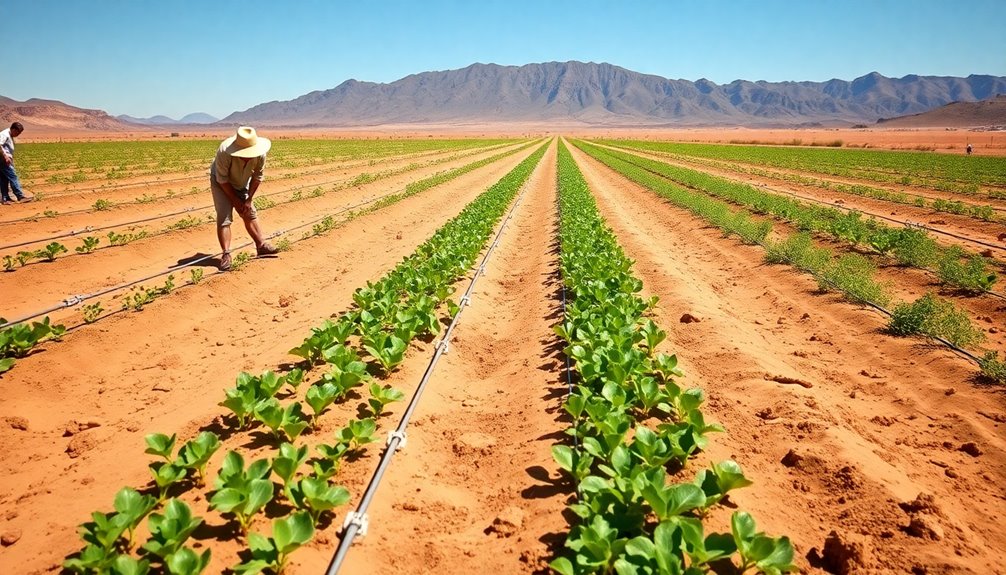
When you're farming in arid regions, it's crucial to adopt techniques that conserve moisture and maximize efficiency. Utilizing drip irrigation systems helps you deliver water directly to your crops, minimizing evaporation losses.
Pairing this with drought-resistant crop varieties, like sorghum and millet, guarantees your harvest thrives despite limited rainfall. Implementing dryland farming techniques, such as contour plowing and crop rotation, further enhances moisture conservation and soil health.
Don't overlook soil conservation practices like mulching and using organic amendments, which help combat erosion and maintain nutrient levels.
Environmental Challenges
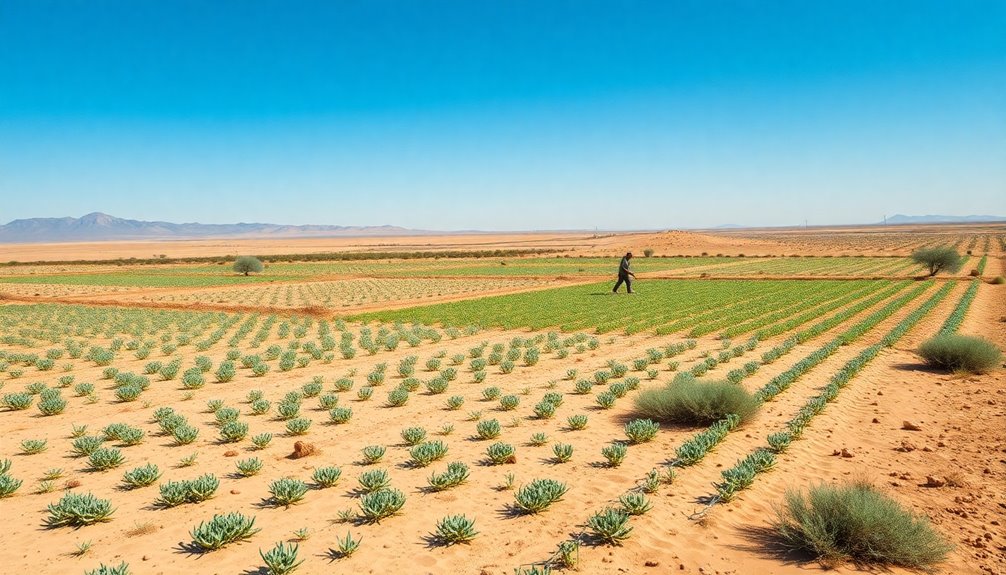
In dry areas, rising temperatures lead to higher evaporation rates, which seriously cuts down on water availability for your crops.
This challenge is compounded by soil degradation, making it harder to maintain productive farmland.
You'll need to adapt your farming practices to tackle these pressing environmental issues effectively.
Evaporation Rate Increase
High annual temperatures in arid regions pose considerable challenges to agriculture, as evaporation rates can soar beyond 100 inches per year. This increase in evaporation contributes to soil moisture depletion, making it tough to sustain crop growth.
During hot seasons, you might notice evaporation rates climbing to 0.1 to 0.3 inches per day, severely impacting the effectiveness of traditional irrigation methods. In fact, evaporation losses can account for up to 50% of the total water you apply, highlighting the urgent need for efficient water management practices.
Implementing techniques like drip irrigation can greatly reduce water loss and help you adapt to these challenging conditions. With climate change expected to further exacerbate evaporation rates, proactive strategies are essential for successful farming.
Low Water Availability
Farming in arid regions is challenging due to the stark reality of low water availability. With annual precipitation often below 10 inches, you'll find that securing a reliable water supply for crops is tough.
High evaporation rates can exceed 100 inches yearly, making moisture conservation essential for effective farming. To combat these issues, consider adopting advanced irrigation methods, such as drip or sprinkler systems, which optimize water usage and minimize waste.
Additionally, think about implementing soil moisture retention practices, such as mulching or cover cropping, to enhance your land's ability to hold water. As climate change continues to raise temperatures and increase drought frequency, these strategies become even more critical for sustaining agriculture in dry areas.
Soil Degradation Risks
While the allure of farming in arid regions can be strong, the reality is that soil degradation poses significant risks to your agricultural success. In a dry climate, it's crucial to recognize the factors contributing to this issue:
- Erosion can lead to a loss of topsoil and essential nutrients.
- Desertification may reduce agricultural productivity by up to 50%.
- High temperatures increase evaporation, further depleting soil moisture.
- Overuse of land depletes nutrients, creating a cycle of declining soil health.
To combat these soil degradation risks, aim for sustainable practices.
Effective Water Management
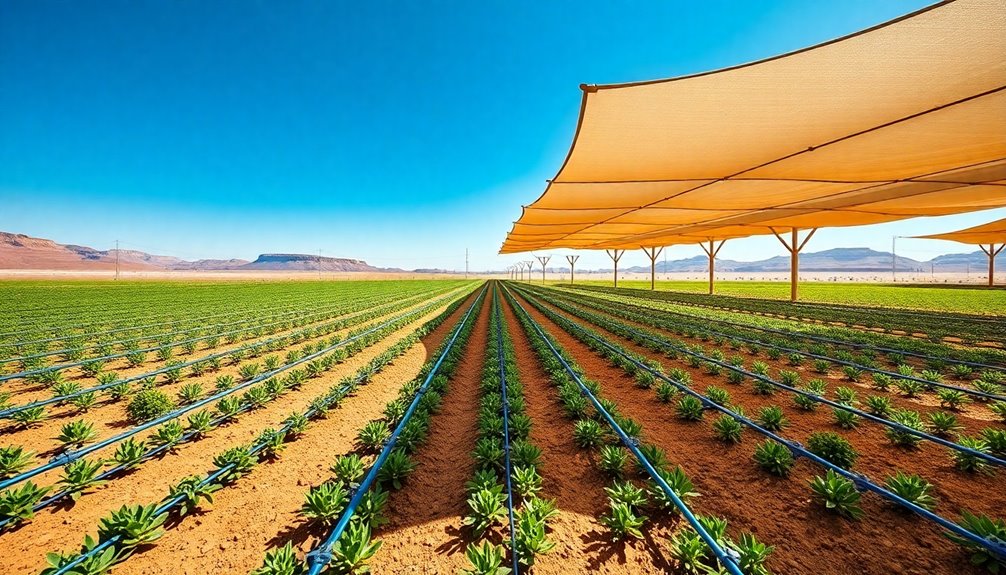
When managing water effectively in dry areas, you'll want to contemplate techniques like drip irrigation, which can save you a significant amount of water.
Rainwater harvesting can also be a game-changer, allowing you to capture and store precious precipitation.
Additionally, using soil moisture retention methods can enhance your water management strategies, ensuring your crops thrive even in arid conditions.
Drip Irrigation Advantages
Drip irrigation can cut water usage by up to 50% compared to traditional methods, making it a game-changer for effective water management in dry areas. This technique delivers water directly to plant roots, ensuring optimal resource use.
Here are some key advantages:
- Minimized evaporation: Water's delivered directly to the soil, reducing loss.
- Enhanced crop yields: A consistent moisture supply promotes healthy plant growth.
- Reduced labor costs: Automation streamlines the watering process.
- Weed suppression: Targeted application helps limit weed growth.
Rainwater Harvesting Techniques
Rainwater harvesting techniques offer a practical solution for effective water management in dry areas, helping you capture and utilize valuable rainfall. By collecting rainwater from rooftops and other surfaces, you can greatly reduce your reliance on groundwater.
Using cisterns, barrels, or underground tanks allows you to store this water for agricultural use during dry periods. This irrigation method can increase water availability by up to 50%, boosting the resilience and productivity of your crops.
It's vital to filter and treat the collected rainwater to guarantee it's safe for irrigation, which helps improve soil moisture levels and reduce erosion.
Tailoring your rainwater harvesting system to local rainfall patterns is imperative for maximizing efficiency and effectiveness.
Soil Moisture Retention Methods
Implementing effective soil moisture retention methods is essential for maximizing water availability in dry areas. By adopting these strategies, you can greatly improve water retention and promote healthier crops in the desert:
- Deep Ploughing: Enhances soil structure and reduces evaporation.
- Mulching: Using organic materials like compost can increase soil's water retention capacity by up to 30%.
- Cover Crops: Protects soil from erosion and boosts moisture retention through added organic matter.
- Contour Plowing: This minimizes water runoff and captures rainwater, maintaining soil moisture levels effectively.
These techniques collectively contribute to better soil moisture retention, ensuring your crops thrive even in challenging dry conditions.
Soil Improvement Techniques
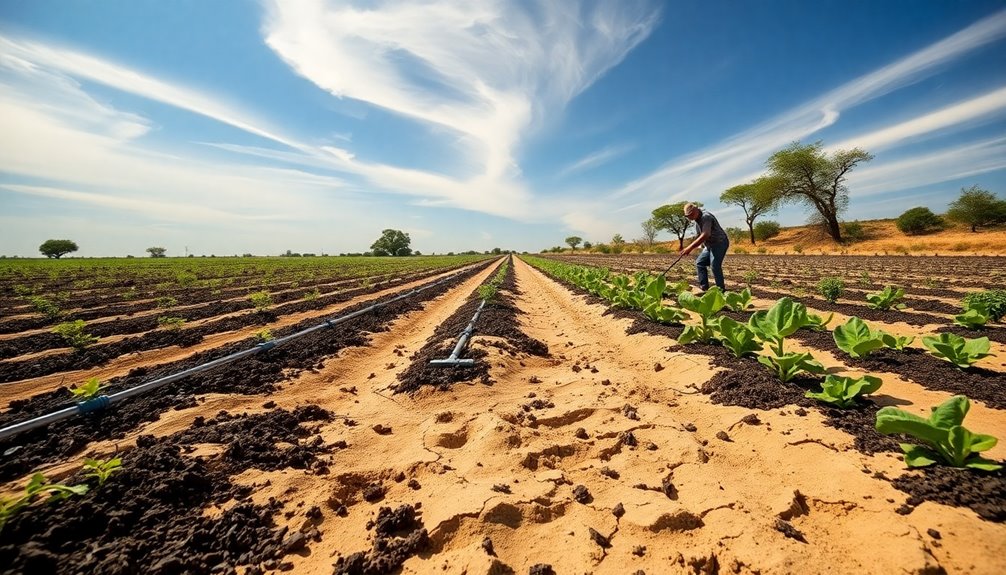
In arid regions, improving soil quality is essential for successful farming. One effective soil improvement technique is adding organic materials like compost and manure, which enhance soil structure and boost moisture retention.
You can also incorporate crop rotation with legumes to fix nitrogen, reducing reliance on synthetic fertilizers while nurturing healthier soil ecosystems. Practicing conservation tillage minimizes soil disturbance, which helps prevent erosion and maintains moisture levels.
Additionally, utilizing cover crops during fallow periods can prevent soil erosion and suppress weeds, enriching the soil with organic matter as they decompose.
Remember to conduct soil testing to gauge nutrient levels and pH, allowing you to make targeted amendments that optimize crop growth in dry environments.
Crop Selection Strategies
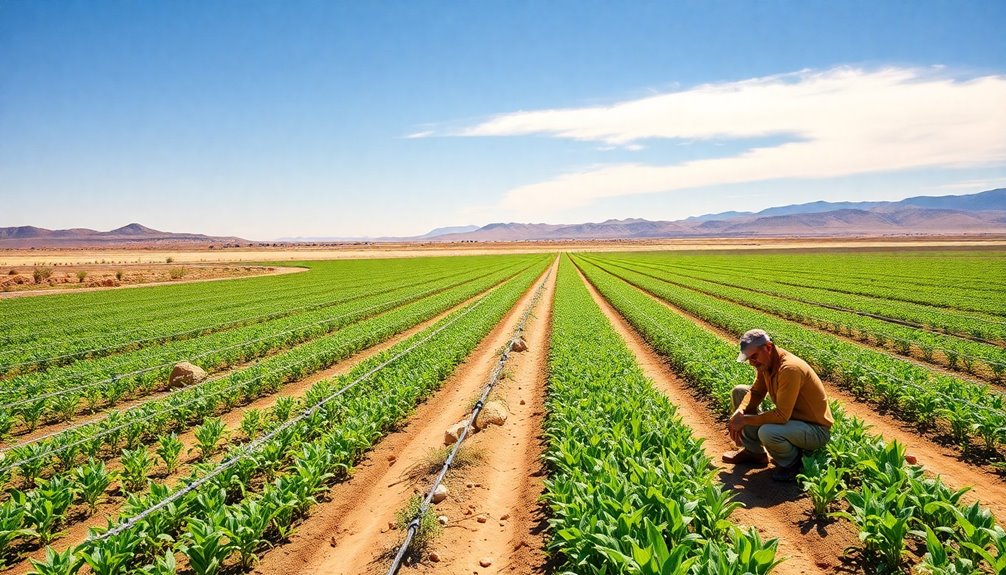
Choosing the right crops is essential for thriving in dry areas. Effective crop selection strategies can make a significant difference.
Here are four key approaches you should consider:
- Drought-Resistant Varieties: Opt for crops like sorghum, millet, and legumes that thrive in arid conditions.
- Native Plants: Incorporate local flora adapted to your climate to enhance resilience and lower irrigation needs.
- Perennial Crops: Choose perennial plants that grow back yearly, requiring less water and maintenance.
- Crop Rotation and Intercropping: Implement crop rotation to improve soil health and consider intercropping to maximize land use and resource efficiency.
Technological Innovations in Dry Farming
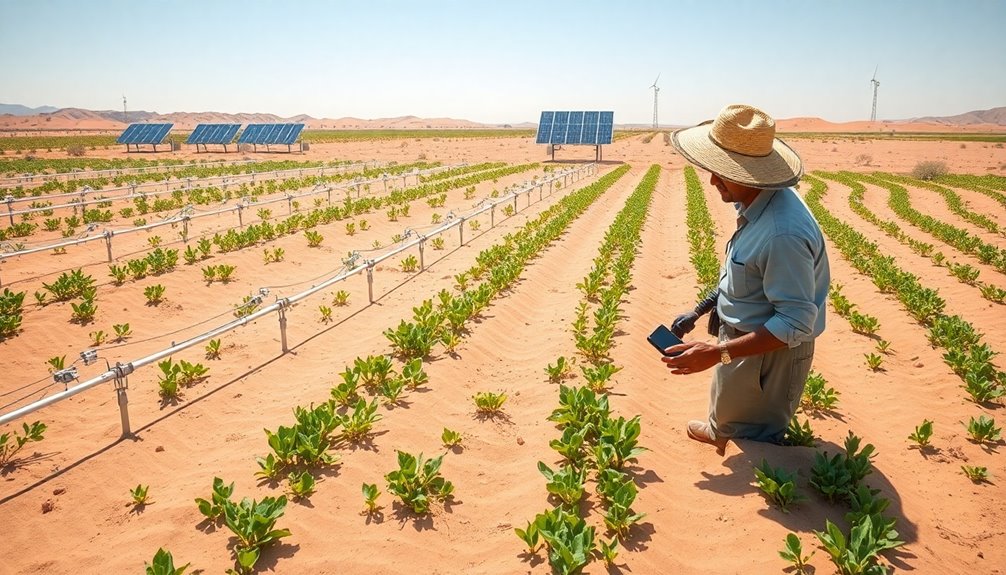
Innovation is revolutionizing dry farming, making it more efficient and sustainable than ever before.
You can leverage automated irrigation systems like advanced drip irrigation to deliver precise amounts of water directly to plant roots, minimizing waste and reducing labor costs.
Soil moisture sensors provide real-time data on soil conditions, helping you optimize irrigation schedules and use water more effectively.
Mobile applications offer timely weather forecasts and tailored farming tips, enhancing your decision-making in arid regions.
By adopting climate-smart agriculture practices, you can adapt traditional methods to meet climate challenges, promoting resilience and sustainability.
Additionally, genetic modification techniques are being developed to enhance drought resistance in crops, ensuring food security even in low-water conditions.
Frequently Asked Questions
What Farming Method Is Used to Dry or Desert Areas?
When you're farming in dry or desert areas, you'll want to focus on methods that conserve water.
Techniques like drip irrigation deliver water directly to plant roots, cutting waste. You might also consider drought-resistant crops like sorghum and millet.
Implementing soil conservation practices, such as mulching, can help maintain soil health.
What Farming Method Is Used in Dry or Desert Areas in Chinampas?
Chinampas, a unique farming method, allows you to cultivate in dry or desert areas effectively.
By creating small plots on shallow lake beds, you're leveraging the surrounding water for natural irrigation. This technique offers nutrient-rich soil and a microclimate that supports diverse crops.
You'll enjoy multiple harvests each year, boosting your food production considerably. Plus, chinampas help combat soil erosion, making it a sustainable choice for challenging agricultural environments.
What Is a Farming Method Used in Extremely Dry Climates?
Did you know that over 1 billion people live in areas affected by severe drought?
In extremely dry climates, one effective farming method you can use is dryland farming. This technique focuses on conserving moisture through practices like contour plowing and crop rotation.
What Are Farming Techniques in the Desert?
When you're farming in the desert, you'll want to focus on techniques that conserve moisture and maximize water efficiency.
Consider using drip irrigation to deliver water directly to your plants' roots, reducing waste. You can also implement contour plowing and crop rotation to maintain soil health.
Opt for drought-resistant crops like sorghum and millet, and explore rainwater harvesting to collect precious precipitation.
These practices will help guarantee your farming efforts thrive in harsh conditions.
Conclusion
In arid regions, adopting the right farming methods can truly make a difference. Did you know that dryland farming can yield up to 50% more food than traditional methods in drought-prone areas? By implementing effective water management, improving soil health, and selecting resilient crops, you can not only sustain agriculture but also help communities thrive. Embracing these best practices not only supports your livelihood but also contributes to global food security in the face of climate challenges.

